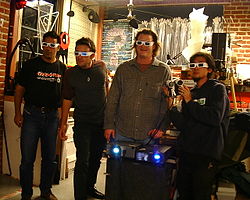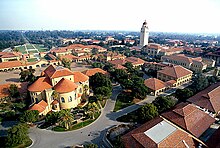Stanford Joint Program in Design
Joint Program in Design | |
| Motto | A joint design program of Art and Engineering. Focus on innovation, research, & design of new products. |
|---|---|
| Established | 1958 |
Parent institution | Stanford University |
| Students | 25 (all graduate) |
The Joint Program in Design or "Stanford Design Program" was a graduate program jointly offered by the Mechanical Engineering Department and the Art Department at Stanford University,[1] in Stanford, in the U.S. state of California. It was discontinued with the last cohort of students graduating in Spring 2017 and is succeeded by the Stanford Design Impact Engineering Master's Degree.[2] It is generally considered a leading design program in the United States. The program offered degrees in Mechanical Engineering and in Fine Arts/Design and was closely connected with the Stanford d.school (The d.school is not one of the seven schools at Stanford and does not grant degrees[3]).
Background

The program was founded in 1958. It has three full-time faculty. It maintains very close links with the venture capital, finance and technology firms of nearby Silicon Valley. [citation needed]
Admissions statistics and student profile

The program has historically been the most selective program at the already highly selective Stanford. [citation needed]
History
Stanford's Design program dates from 1958 when Professor John E. Arnold, formerly of the Massachusetts Institute of Technology, first proposed the idea that design engineering should be human-centered. This was a radical concept in the era of Sputnik and the early Cold War. Building on Arnold's work, Bob McKim (Emeritus, Engineering) along with Matt Kahn (Art), created the Product Design major and the graduate-level Joint Program in Design. This curriculum formalized in the mid-1960s, making the Joint Program in Design (JPD) one of the first inter-departmental programs at Stanford or other nationally prominent Universities. The texts in those days were McKim's recently published Experiences in Visual Thinking, and Jim Adams', Conceptual Blockbusting, a Guide to Better Ideas. The "loft" was a bootleg attic space in Building 500 that the University didn't know about (and the faculty pretended didn't exist). ME101: Visual Thinking was the introductory class for all product design students and the class included four "voyages" in the Imaginarium, a 16-foot geodesic dome that presented state-of-the art multimedia shows designed to stimulate creativity.
The Loft moved to its current location behind the Old Firehouse. Bob McKim went Emeritus; Matt Kahn, Rolf Faste and David Kelley continued instruction in the tradition of merging art, science and needfinding though the 1980s and 1990s. Forty-some years later ME101 is still taught, although the Mechanical Engineering Department and the Department of Art no longer continue their historic collaboration with faculty drawn from both schools for instruction.
See also
References
External links
- Official Web Site
- A wiki of suppliers, classes, designer, and resources for designers
- Rolf A. Faste Foundation for Design Creativity
"Santa Clara County, California" is an invalid category parameter for Template:Coord missing.
The problem is usually caused either by a spelling mistake or by an-over-precise category.
For a full list of categories, see Category:Unclassified articles missing geocoordinate data and its subcategories.
